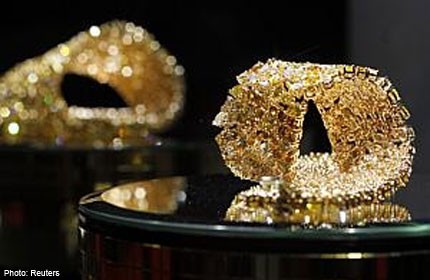Going for gold, but not at record-breaking pace


UNITED STATES - Gold has been an extraordinary investment since it bottomed around US$250 an ounce in the autumn of 2001. Since then, it has risen 662 per cent to around US$1,880, fallen back to around US$1,525 and is currently US$1,700.
As opposed to the bearish views around 9/11, the vast majority of advisers now maintain that investors should have a 5-10 per cent holding in gold. With the exception of Goldman Sachs - which recommended profit-taking recently - predictions for next year range from US$1,750 to US$2,100 an ounce with the consensus at US$1,850. In today's money, the 1980 peak of US$850 would be around US$2,300, so bullish advisers say the metal is at fair value.
The most popular bullish argument is that the US, Europe and now Japan are intent on quantitative easing - that is, boosting money supply. With interest rates close to zero and government bond yields pitiful, US Federal Reserve Board chairman Ben Bernanke has effectively launched a currency war.
"By printing all this money, Bernanke is debasing the dollar, as the rest of the world is not printing money as fast as the US," says John R Taylor, chief investment officer at FX Concepts, a large foreign exchange fund. "As a result, in the long run, foreign currencies will go up in value, and commodities like gold and oil will rise in dollar terms."
With these bullish factors in play, gold holders are wondering why the price isn't taking off.
A simple reason is that global investors already own a massive quantity of gold via bullion in vaults and exchange-traded products (ETPs) such as GLD. According to the World Gold Council (a research and promotion organisation that promotes the interests of goldmines), investment in gold has been accelerating at a fast pace.
In 2002, total investment was 352 tonnes and exchange-traded gold products had as yet not come on stream. By 2011, total bar, coin and exchange-traded products reached 1,704 tonnes and, in the first three quarters this year, amounted to 1,130 tonnes. This indicates that the market is very long in gold (that is, it already holds a lot), so in some respects asset managers are talking their book.
Meanwhile, jewellery demand - which was 2,662 tonnes in 2002 and accounted for more than 90 per cent of total demand then - declined to 1,972 tonnes in 2011 because of the steep rise in price. In the first nine months of this year, jewellery demand came to 1,353 tonnes - only 42 per cent of total demand.
In other words, the jewellery industry is under pressure because of high prices and the market is now very dependent on more investors accepting much higher prices than earlier in the decade.
JPMorgan also has some explanations: "Gold is up 10 per cent year-to-date, but has effectively been in a range since September 2011. This has caused some to question whether the bull run in gold that started in 2000 has come to an end. What has been driving this lacklustre performance? We think an important explanation is the weakness in emerging market growth, equities and currencies against the dollar."
JPMorgan estimates that around 75 per cent of physical gold demand comes from emerging markets. The past decade's rally in gold coincided with the rise of emerging market economies and the rapid appreciation of their currencies against the dollar. This meant that the price of gold imports for emerging market importers such as India and Asian nations was cheaper than the international US dollar price.
JPMorgan predicts a rally in emerging market currencies which should raise imports, and thus predicts a price of US$1,800 an ounce next year. Moreover, further central bank balance sheet expansion coupled with increased tolerance of higher inflation should support gold, the investment bank maintains.
Central banks are also continuing to diversify their reserves into gold, and that should underpin the price. In 2011, they bought 411 tonnes and in the first nine months of this year, 374 tonnes.